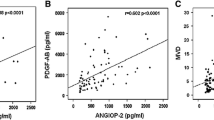Abstract
Molecular balance between Angiopoietin-1 (Ang-1) and Angiopoietin-2 (Ang-2) has important effects in tumor angiogenesis. Ang-2 was shown to be elevated and proved to be a prognostic factor in acute myeloid leukemia (AML). To date studies revealed increased angiogenesis in bone marrows (BMs) of both myeloproliferative neoplasm (MPN) and AML patients. We conducted this study to demonstrate circulating levels of Ang-1 and Ang-2 in MPN patients since no data exists in literature. Thirty-three newly diagnosed MPN, 27 newly diagnosed AML patients and 25 controls (HC) were enrolled and Angiopoietin levels were determined with ELISA. We found that Ang-1 levels were higher whereas Ang-2 levels were lower in MPN and HC when compared to AML. Our results suggest that though angiogenesis is increased in both AML and MPN, angiopoietin serum level profile of the two diseases are different, and MPN patients have similar Ang-1 and Ang-2 levels as HC. We conclude that, according to our results Ang-1 and Ang-2 do not only regulate tumor angiogenesis and the difference between angiopoietin levels of acute and chronic myeloid neoplasms could be a reflection of other effects of these growth factors on tumor malignancy.



Similar content being viewed by others
References
Saharinen P, Eklund L, Pulkki K, Bono P, Alitalo K (2011) VEGF and angiopoietin signaling in tumor angiogenesis and metastasis. Trends Mol Med 17:347–362
Khosravi Shahi P, Fernández Pineda I (2008) Tumoral angiogenesis: review of the literature. Cancer Invest 26:104–108
Gianelli U, Vener C, Raviele PR, Savi F, Somalvico F, Calori R, Iurlo A, Radaelli F, Fermo E, Bucciarelli P, Bori S, Coggi G, Deliliers GL (2007) VEGF expression correlates with microvessel density in Philadelphia chromosome-negative chronic myeloproliferative disorders. Am J Clin Pathol 128:966–973
Lundberg LG, Lerner R, Sundelin P, Rogers R, Folkman J, Palmblad J (2000) Bone marrow in polycythemia vera, chronic myelocytic leukemia, and myelofibrosis has an increased vascularity. Am J Pathol 157:15–19
Kvasnicka HM, Thiele J (2004) Bone marrow angiogenesis: methods of quantification and changes evolving in chronic myeloproliferative disorders. Histol Histopathol 19:1245–1260
Hussong JW, Rodgers GM, Shami PJ (2000) Evidence of increased angiogenesis in patients with acute myeloid leukemia. Blood 95:309–313
Dickson DJ, Shami PJ (2001) Angiogenesis in acute and chronic leukemias. Leuk Lymphoma 42:847–853
Alonci A, Allegra A, Bellomo G, Penna G, D’Angelo A, Quartarone E, Musolino C (2008) Evaluation of circulating endothelial cells, VEGF and VEGFR2 serum levels in patients with chronic myeloproliferative diseases. Hematol Oncol 26:235–239
Medinger M, Mross K (2010) Clinical trials with anti-angiogenic agents in hematological malignancies. J Angiogenes Res 2:10
Musolino C, Alonci A, Bellomo G, Loteta B, Quartarone E, Gangemi D, Massara E, Calabrò L (2004) Levels of soluble angiogenin in chronic myeloid malignancies: clinical implications. Eur J Haematol 72:416–419
Shim WS, Ho IA, Wong PE (2007) Angiopoietin: a TIE(d) balance in tumor angiogenesis. Mol Cancer Res 5:655–665
Lee CY, Tien HF, Hu CY, Chou WC, Lin LI (2007) Marrow angiogenesis-associated factors as prognostic biomarkers in patients with acute myelogenous leukaemia. Br J Cancer 9:877–882
Schliemann C, Bieker R, Thoennissen N, Gerss J, Liersch R, Kessler T, Büchner T, Berdel WE, Mesters RM (2007) Circulating angiopoietin-2 is a strong prognostic factor in acute myeloid leukemia. Leukemia 21:1901–1906
Kümpers P, Koenecke C, Hecker H, Hellpap J, Horn R, Verhagen W, Buchholz S, Hertenstein B, Krauter J, Eder M, David S, Göhring G, Haller H, Ganser A (2008) Angiopoietin-2 predicts disease-free survival after allogeneic stem cell transplantation in patients with high-risk myeloid malignancies. Blood 112:2139–2148
Hou HA, Chou WC, Lin LI, Tang JL, Tseng MH, Huang CF, Yao M, Chen CY, Tsay W, Tien HF (2008) Expression of angiopoietins and vascular endothelial growth factors and their clinical significance in acute myeloid leukemia. Leuk Res 32:904–912
Tefferi A, Vardiman JW (2008) Classification and diagnosis of myeloproliferative neoplasms: the 2008 World Health Organization criteria and point-of-care diagnostic algorithms. Leukemia 22:14–22
Vardiman JW, Thiele J, Arber DA, Brunning RD, Borowitz MJ, Porwit A, Harris NL, Le Beau MM, Hellström-Lindberg E, Tefferi A, Bloomfield CD (2009) The 2008 revision of the World Health Organization (WHO) classification of myeloid neoplasms and acute leukemia: rationale and important changes. Blood 114:937–951
Quartarone E, Alonci A, Allegra A, Bellomo G, Calabrò L, D’Angelo A, Del Fabro V, Grasso A, Cincotta M, Musolino C (2006) Differential levels of soluble angiopoietin-2 and Tie-2 in patients with haematological malignancies. Eur J Haematol 77:480–485
Medinger M, Skoda R, Gratwohl A, Theocharides A, Buser A, Heim D, Dirnhofer S, Tichelli A, Tzankov A (2009) Angiogenesis and vascular endothelial growth factor-/receptor expression in myeloproliferative neoplasms: correlation with clinical parameters and JAK2-V617F mutational status. Br J Haematol 146:150–157
Mazzieri R, Pucci F, Moi D, Zonari E, Ranghetti A, Berti A, Politi LS, Gentner B, Brown JL, Naldini L, De Palma M (2011) Targeting the ANG2/TIE2 axis inhibits tumor growth and metastasis by impairing angiogenesis and disabling rebounds of proangiogenic myeloid cells. Cancer Cell 19:512–526
Scholz A, Lang V, Henschler R, Czabanka M, Vajkoczy P, Chavakis E, Drynski J, Harter PN, Mittelbronn M, Dumont DJ, Plate KH, Reiss Y (2011) Angiopoietin-2 promotes myeloid cell infiltration in a β2-integrin-dependent manner. Blood 118:5050–5059
Kim H, Koh GY (2011) Ang2, the instigator of inflammation. Blood 118:4767–4768
Conflict of interest
The authors report no declarations of interest.
Author information
Authors and Affiliations
Corresponding author
Rights and permissions
About this article
Cite this article
Atesoglu, E.B., Tarkun, P., Mehtap, O. et al. Serum Angiopoietin Levels are Different in Acute and Chronic Myeloid Neoplasms: Angiopoietins do not only Regulate Tumor Angiogenesis. Indian J Hematol Blood Transfus 32, 162–167 (2016). https://doi.org/10.1007/s12288-015-0548-8
Received:
Accepted:
Published:
Issue Date:
DOI: https://doi.org/10.1007/s12288-015-0548-8




